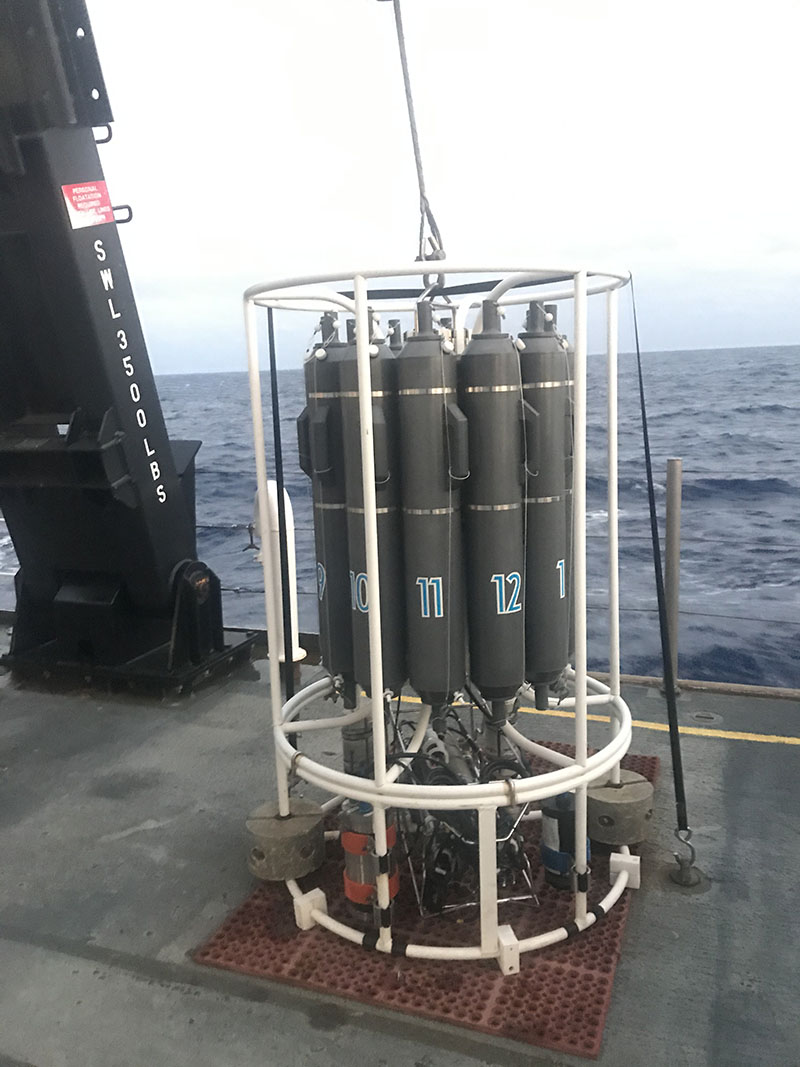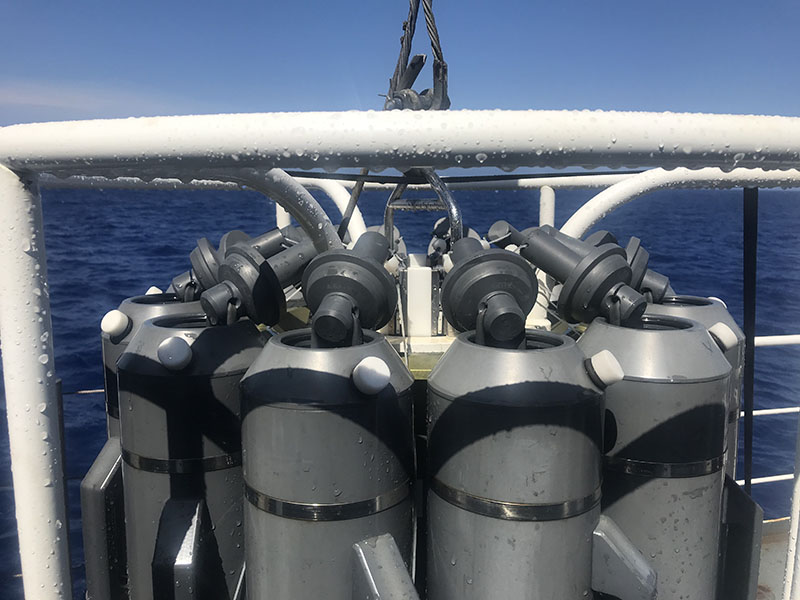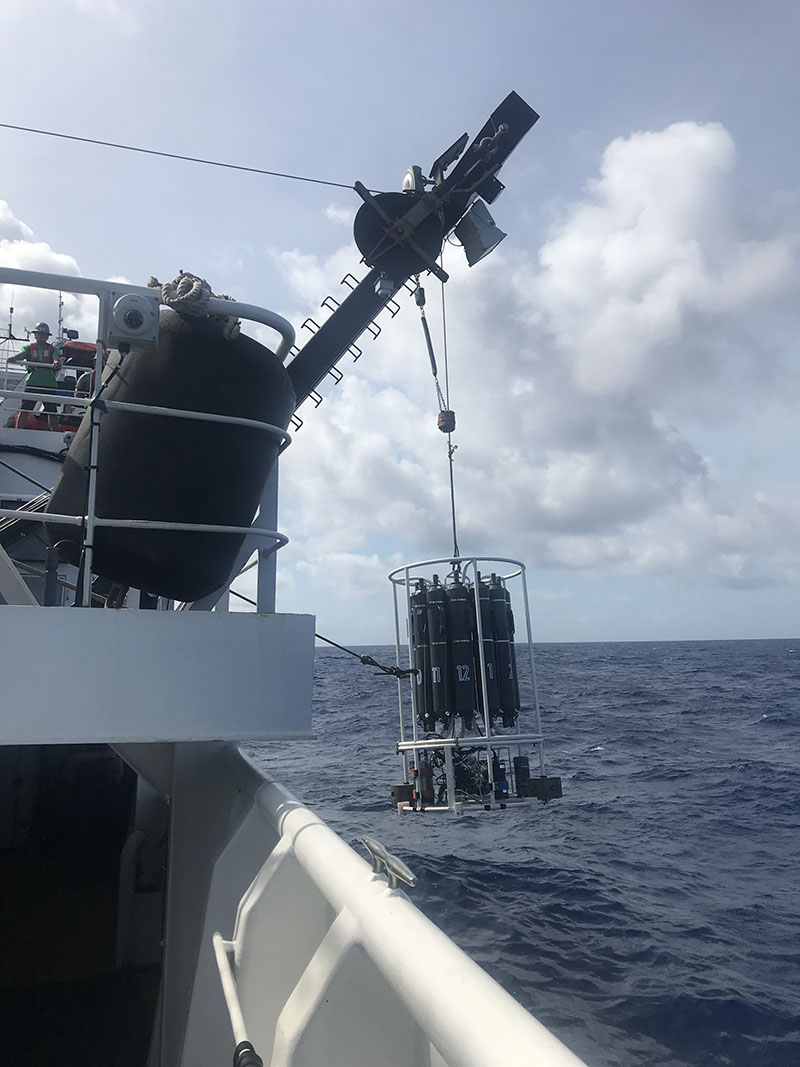
Lu Wang, Sea Grant Knauss Fellow, NOAA Ocean Exploration
Published May 10, 2021
Earth’s ocean has an average depth of 3,682 meters (2.3 miles), which is about 40 football fields. Some parts, such as Challenger Deep within the Mariana Trench in the Pacific Ocean, can get down to 11,034 meters (6.7 miles), which is the deepest place in the ocean.
Within these large columns of water that span thousands of meters deep, there exist gradients or layers of water with different environmental characteristics based on depth, including distinct temperature, salinity, pH, oxygen, labile carbon, and nutrient measurements. These environmental characteristics can then impact what is found within the water column at each depth, from marine bacteria to megafauna. Sampling and subsequent analyses of water at each particular depth can help us further understand the environmental and biological characteristics of the ocean.
One way to sample water throughout the water column is through the use of Niskin bottles. These bottles come in a variety of sizes, but all have a lid on the top and bottom. On NOAA Ship Okeanos Explorer, our 10-liter Niskin bottles are attached to a large metal frame called a Conductivity Temperature Depth (CTD) rosette. This device is called a CTD rosette because a CTD, which measures conductivity, temperature, and depth, among other oceanographic features, is also attached to the frame.

CTD rosette on NOAA Ship Okeanos Explorer, complete with CTD (bottom section) and 12 Niskin bottles (top section). Image courtesy of NOAA Ocean Exploration, 2021 EM 304 Sea Acceptance Testing and Mapping Shakedown. Download image (jpg, 2.4 MB).
The CTD rosette attaches to the ship via a long cable and is deployed through the CTD winch, allowing the entire device to traverse to the seafloor. The process of deploying a CTD rosette into the water is called a CTD cast. Each CTD cast can take about two to six hours to complete, depending on the depth of the sampling, the number of water samples required, and other factors. CTD casts are a team effort, requiring the attention of two to three crew members and the senior survey technician (SST).
On deployment, the lids of all Niskin bottles are open and stay open until the CTD rosette hits a target depth. This allows water to flow freely through the bottles during deployment, ensuring a smooth trip down the water column.
Meanwhile, inside the ship’s dry lab, the SST can observe the CTD measurements that are recorded and transmitted to the lab computers in real time, both on CTD deployment and recovery. Once the CTD rosette has hit the deepest target water depth and is on its way back up to the sea surface, the SST can begin water sampling.
As the CTD rosette approaches each sample collection depth, the SST will begin slowing down the speed of the CTD, starting at about 50 meters (164 feet) from the collection point. The SST will fully stop the CTD once it reaches the collection point. This prevents water disturbance and ensures that the Niskin bottles are actually capturing the water at that desired collection depth.
To trap water in a Niskin bottle, the SST can remotely deploy a latch holding the top lid of a Niskin bottle, releasing the lid. Niskin bottle lids are connected inside the bottle with rubber tubing, creating tension that will cause the bottom lid to close when the top lid is closed, successfully trapping water from a specified depth inside the bottle. This process is repeated at each depth of interest until all samples are collected and the CTD rosette reaches the ocean surface.

A closer look at the latch system that holds the Niskin lids together. The top Niskin bottle lid is also connected to the bottom lid via rubber tubing, creating tension inside the bottle that will ensure both lids close simultaneously. Image courtesy of NOAA Ocean Exploration, 2021 EM 304 Sea Acceptance Testing and Mapping Shakedown. Download image (jpg, 2.7 MB).
Upon retrieval, the CTD rosette is lifted out of the ocean and brought back on the deck of the ship. At this stage, the crew is strapped to the ship as a safety measure and also uses a hook to help navigate the CTD rosette back to the ship. The crew will also make sure all cables are stowed away and the deck is safe for mission personnel to collect the water samples.

CTD rosette being lifted out of the ocean via cable and a hook from the starboard side of NOAA Ship Okeanos Explorer. Image courtesy of NOAA Ocean Exploration, 2021 EM 304 Sea Acceptance Testing and Mapping Shakedown. Download image (jpg, 2.5 MB).
To retrieve the water samples, a cap at the top of the Niskin bottle must be removed to release air pressure inside the bottle. Then, water can be collected from the spigot at the bottom of each Niskin bottle. These water samples can then be used for downstream analysis, like eDNA. Results from water sample analyses can also be compared to oceanographic measurements from the CTD, which can help scientists develop a better ecological understanding by combining physical data with biological data. After all water samples are collected, the CTD rosette is rinsed off and covered, ready for its next mission.

Water sample retrieval from the spigot of Niskin bottle 9. Image courtesy of NOAA Ocean Exploration, 2021 EM 304 Sea Acceptance Testing and Mapping Shakedown. Download image (jpg, 3.3 MB).